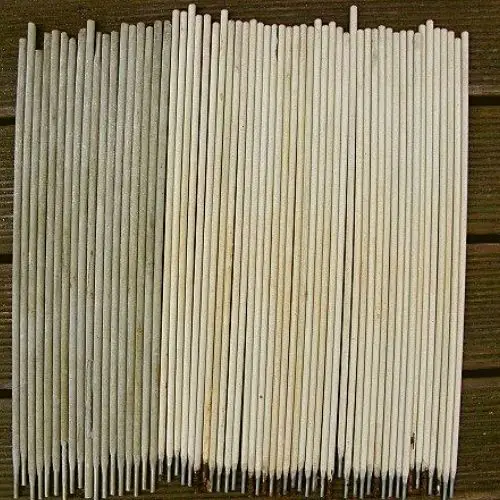
If you’re a first-time welder, you may not be aware of the differences that lie between 6010 and 6011 rods. Hope I can answer some of your questions with this post.
6010 and 6011 are virtually the same rods, in fact, a lot of people can not tell the difference between the two. They both have a strong penetrating arc, great to penetrate through rust and zinc for example, and they are fast-freeze rods. The biggest difference, however, is the fact that 6010 can only be used with DCEP polarity and 6011 can be used with DCEP and AC. So in other words, 6011 is the AC version of 6010.
For more detailed information, keep reading ahead!
What Is the Difference Between 6010 and 6011 Welding Rods?
Contents
Both 6010 and 6011 are commonly used welding rods which are often confused for each other. Their difference lies in their last numerals, “0” and “1” which account for their different flux composition, slag type, and current type that can be used.
6010 has high cellulose sodium-type coating, whereas 6011 has high cellulose potassium-type coating.
Another major fact that separates their uses is that 6011 can run on both AC as well as DCEP models. Due to this, 6011 may has more uses in comparison to the other welding rods that run only on DCEP.
| 6010 | 6011 | |
| Tensile Strength | 60000 PSI | 60000 PSI |
| Position | All positions | All Positions |
| Polarity | DCEP | DCEP,DCEN, AC |
| Arc Characteristics | Violent | Violent |
| Flux composition | cellulose sodium (Fast Freeze) | cellulose potassium (Fast Freeze) |
| Slag Type | Thin, Flaky, does not peel | Thin, flaky, does not peel |
| Motion | Slight drag / Can whip (stich) | Slight drag / Can whip (stich) |
| Penetration | High | High |
| My recommendation from Amazon | More details | More details |
What Is the Difference in Polarity Between 6010 and 6011 Welding Rods?
Polarity results from an electrical circuit having either a negative or a positive pole.
6010 electrodes’ polarity is DCEP. On the other hand, 6011’s polarity is variable since it can run on both DCEP and AC sources. This makes 6011 a great farm rod to be used in AC-only machines.
So, due to the flexibility of 6011, you can adjust and choose between polarities.
Moreover, keep in mind that even if you have got a DC machine or one that can handle variable polarities, 6011 will not let you down in either of the circumstances!
Which Penetrates Better 6010 vs 6011?
Unlike many other welding rods, both 6010 and 6011 have excellent penetration power.
However, there is still a slight difference as 6011 has higher penetration and cleaning power in comparison to 6010.
You can assume the 6011 electrodes as a better version of the 6010 electrodes as it fulfills the need for all-purpose welding.
Although the 6011 is a better penetrator, the 6010 rod still has a great penetration power. In fact, it is an excellent penetrator and leaves just about a little slag behind.
Can I Weld in All Positions With Both Welding Rods?
Yes, both 6011 and 6010 can be run in flat, horizontal, vertical and overhead positions. The reason behind it is the fact that they do not produce a lot of slag, and as I mentioned earlier, they are fast-freeze rods.
In addition to this, they also work on rusty, and contaminated materials.
As 6010 and 6011 are cellulosic electrodes, they’re perfect for root passes, exclusively on DC +.
Uses of 6010 and 6011
Both 6010 and 6011 are very popular rods. They are mainly used where deep penetration is needed or in situations where you need to weld on contaminated surfaces like rust and whatnot. However, amongst professionals, 6010 is preferred. Thanks to better flux composition it is more suitable for working on more critical projects like pipe welding.
All in all, if you already have some experience under your belt to run rods with more violent arc than 6013, they both are great for hobby welders and general repair jobs
6010 vs 6011 Rods: How to Decide Which One to Go For?
If you have a hard time picking which one to use, the only way you could possibly know is to try out both of them. They run almost the same, the arc itself, slag, penetration – Really hard to tell the difference.
If you have an AC-only machine, you have to go with 6011, but otherwise, try both of them out.
If you do not want to try both of them and you have DC machine go with 6010.
Frequently asked questions
Unlike 6010 which can be only used on DCEP, 6011 can be used on both AC and DCEP. However, neither of those rods are suitable for DCEN.
As they are members of mild steel type and melting base category, welding cast iron with 6011 electrodes is possible, but only on hobby projects. It is not a suitable rod for cast iron. The best option would be 99% nickel rods because of the characteristics of cast iron.
Yes. You can definitely drag a 6010 electrode as the cellulosic slag will burn out thereby forming no inclusions. However, usually, 6010 is a rod to practice your weaving techniques – You can create pretty awesome ripple patterns with it.
Final Thoughts
In conclusion, almost every solid engineer has to face some dilemma to find the best fit. However, once they do, there’s no going back from that!
Similarly, the 6010 and 6011 rods may intimidate many first-time welders as they require more manipulation than the 6013’s. You may also not know the real differences, so I encourage you to try both of them out.
